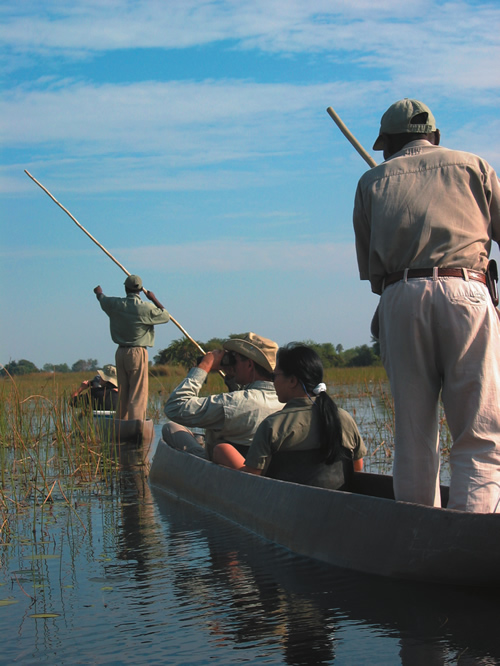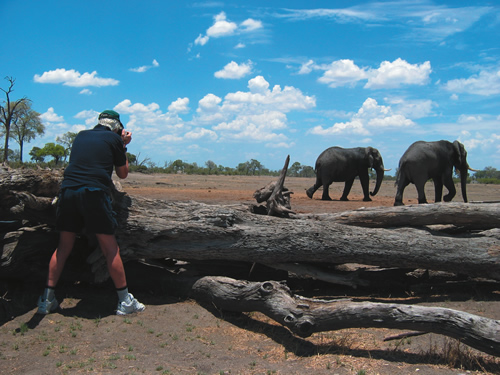Journey Botswana: New Safaris Are Lessons in Ecology
By Rob Sangster
Our concept of safari was influenced by Hemingway’s Snows of Kilimanjaro and later by Out of Africa and the demonic lions in The Ghost and the Darkness. In far too many movies we saw the white hunter slaughter
some animal to “save” a client. There are still safaris for heavily-armed jet-setters who pay thousands of dollars to gun down an unsuspecting elephant, Cape buffalo, giraffe, or sluggish, over-fed lion. But those safaris
are dying out. Replacing them are ones in which shots are taken only through the lens of a camera.
For the lover of the natural world, going on safari is a dream, a once-in-a-lifetime experience. In fact, “safari” is the Swahili word for “journey.” In areas in which hunting is prohibited
animals have learned they have little to fear from the occasional Land Rover bearing soft-shell humans. When we respect their space even the few animals who hunt for a living do everything they can to avoid us.
Because safaris differ so much, I’ll say a few words about several types then answer two questions I hear often: Aren’t safaris hard on the environment? And aren’t they outrageously expensive?
The answer to the first is a resounding “No.” When wildlife is worth more alive than dead, their environment is better protected. The answer to the second question is a qualified “No.” I’ll explain why
below.
My First Modern Safari in Botswana
My November and December safari in Botswana began at Wilderness Safaris’ Kwetsani Camp in the heart of the Okavango Delta, the largest seasonal wetland in the world. It’s so remote that the
only practical way to get there is by light bush plane from the small town of Maun in the Kalahari Desert.
A modern safari focuses on encounters with exotic wildlife in their natural habitat. But it can be so much more. If we toss out the “Animals-I’ve-Spotted” checklist and immerse ourselves in
a very different environment, a safari becomes a feast for the senses. We learn the meaning of ecological systems, the interdependence of species, and the complex rhythms of seasons.
Call This a Tent?
The Wilderness Safari brochure referred to “tents” and “camps” but, far from roughing it, guests live in luxury. Kwetsani Camp accommodates only ten people but maintains a staff of 20.
Whether meals were Indian, Chinese, or Continental, they were bountiful, expertly prepared, and always accompanied with tropical fruit, imported cheeses, and irresistible desserts.
To avoid crossing paths with elephants and various passing critters, I reached my secluded bungalow via a raised boardwalk. The bungalow on stilts rose like an elegant tree house into the lower branches of palm
and fig trees.
Facilities included electricity and an en suite full bathroom. Then there was the huge bed with crisp linens strewn daily with fresh flower petals, hand-carved furnishings, locally-designed ceramic tiles, a
spacious deck, and an outdoor shower with a view of wild game parading across the open savanna.
The safari consisted of day and night game drives in a Land Rover with open sides and top, guided nature walks, and trips in a dugout canoe (called a mokoro) into the labyrinth of Delta waterways. We shared
the landscape with lions, leopards, elephants, giraffes, hippos, Cape buffalo, zebras, red lechwe, hyenas, and a zillion impala. The guide, Gregg Hughes, had the kind of knowledge of ecology, botany, geology, and wildlife that could
earn him a university post.

|
|
Taking a canoe on the safari.
|
Elephant Tango
For diversity, I visited Savuti Camp, located on the dry plains of the Kalahari on a low bluff overlooking a riverbed that dried up after a tiny tectonic tilt in 1980 sent the water on a different course. The
river was flowing copiously when Dr. David Livingstone stood on the site in 1851.
Because it also has a waterhole only a few dozen yards from the front deck of the lodge, Savuti is said to attract as many as 4,000 elephants in a single day. The camp’s “hide” (for humans)
at the edge of the waterhole is a rough circle about 30 feet in diameter made of loosely-stacked trunks and limbs from leadwood trees. As a barrier, it’s a very low-feeling four feet high.
Seeing elephants approaching the waterhole, the guide and I ran across the riverbed and climbed inside the hide. A couple of bull elephants stood no more than 25 feet away, drinking and tossing cascades of water
on their backs and stomachs, all the while keeping an eye on us. After a few minutes, the larger of the two bulls suddenly raised his trunk high, flared his ears, and thundered straight at the hide. Just a couple of dozen paces away,
he skidded to a stop but kept his “I’m-very-large-and-fearsome” features in place. When satisfied he’d let us know what he could do if he’d really wanted to, he grunted and turned away.

|
|
Rob takes a photo of some local elephants.
|
What About the Environment?
Because tourism is a significant source of revenue for Botswana, the government has wisely addressed the complicated and potentially stressful interactions among the tourism industry, visitors, local communities,
and the environment. It has implemented an effective ecotourism strategy and set tough ground rules under its “Conservation through Tourism” program. Much like Bhutan, Botswana has opted for “low density, high value” tourism
and has designated more than one third of the country as conservation areas.
To obtain the exclusive right to operate in a given area safari operators must compete against each other in terms of what they will do that’s pro-environment. That includes limiting themselves to a very
low number of beds.
Wilderness, which manages more than two million acres of land in six countries, was selected by National Geographic Traveler and Conservation International to receive a World Legacy Award as best
in the world for wildlife travel. Wilderness has also received ASTA Environmental Award for outstanding achievements in preservation — including white rhino relocation. Inspired by a visit from Paul Newman, Wilderness initiated
a “Children in the Wilderness” program. Needy kids from rural Botswana are brought to one of the camps for a week to learn about wildlife they would otherwise never see. They are also taught environmental management, geography,
and geology. The idea is to use positive learning experiences to raise self-esteem, strengthen the desire to continue in school and ultimately enter a career in wildlife conservation.
Sharing with Local Communities
The guiding principle for Wilderness is sharing. Beyond sharing space equitably with the animals (and they estimate they lose $300,000 a year in revenue from not allowing hunting), they also share profits with
local communities. They bring local people into safari operations and teach them marketable skills. In Botswana, the presence of safari operations, along with vigorous government surveillance, have made poaching an insignificant problem.
The bottom line is that these photographic safari companies have a huge investment in protecting the environment. At least as important, every staff person I met loves the life and the work.
Now for the Bill
Assuming we agree that a pristine environment can afford the safari, can we humans afford the safari? Fees for a mid-range luxury safari camp might run $750 per person per night and go up by season. That, of course, is all-inclusive (from local airfare to fine wines). If the price suits, it’s a great experience. (By the way, you can cut these prices by going in September through March,
the “green” season. The animals are more dispersed then but the green landscape is more beautiful and migratory birds fill the skies.) As always, prices are subject to change, so before booking, check the most recent prices online.
If that’s still too pricey, there are numerous very affordable alternatives. Ask a search engine to find “Botswana cheap safaris” (or Kenya, Tanzania, Zambia, Botswana, or South Africa).
You’ll find plenty to choose from. And websites such as Botswana Budget Safaris provide a useful array of options.
Other Safari Choices in Botswana
The next two types of safari may have a slightly greater impact on the environment than luxury safaris simply because they involve more infrastructure, like larger lodges, and many more people.
When I reached Kenya some years ago carrying a backpack I assumed, based on brochures I’d seen in the States, that safaris were beyond my budget. Within 24 hours, representatives of a dozen Nairobi-based
safari companies had approached me offering very affordable safaris to Masai Mara, Amboseli, Tsavo, and the like. Hakuna matata. No problem.
The vehicles were pop-top Toyota vans and visibility was fine. The tents, real ones, were erected by staff in a different location each night. Meals weren’t fancy but they were always tasty. Paths sometimes
became crowded when a number of van drivers, alerted by radio, converged on one spot. But the upended wildebeest and the bloody-mouthed lions were quite real. Sure, there were more people around than on a luxury safari, but you’re
still out there. I'd guess the cost to be about one-fifth that of a luxury safari.
In Arusha, Tanzania, five of us hired a van and driver from Tourcare (whose owner, Mr. YaSin, consistently provided more than he promised). Our self-directed safari included Lake Manyara, famed for tree-climbing
lions, the 20-mile-wide Ngorongoro Crater, Louis Leakey’s digs at Olduvai Gorge, and the Serengeti plains where millions of wildebeests thudded past on their annual migration. Each night the driver found an affordable lodge and
each morning we had complete freedom to set our course and pace.
From these experiences, I learned a lesson that has served me well. Affordable choices may mean arriving without a confirmed itinerary and booking locally. For many travelers, accepting a little uncertainty
is well worth it to make an African safari affordable.
Not the Real Africa
Being on safari can stoke the spirit and thrill the senses, but it shouldn’t be confused with learning much about diverse African cultures. To do that you must travel slowly, walk the streets, visit markets,
watch and listen. Consider adding at least a week to the end of your safari for a walkabout.
Why Go on Safari?
While it can be satisfying to ride in a vehicle spotting animals, safari companies offer many more options. How about overnighting in an active San Bushmen village, talking with the medicine man, walking the
trails and learning how to make fire, find water, and use a bow and arrow? Or taking off in a mokoro for five days, encountering animals on foot? In other words, more active participation makes the experience more memorable.
On safari we enter a world very different from our daily life. We stand beneath a bright blue sky full of towering cumulus clouds that rise 360 degrees around us from a pan-flat savanna. No longer blinded by
man-made light, we gaze silently at a night sky etched with shooting stars more numerous than taxis on Broadway.
Free from the hum generated by urban life, we hear the rustle made by a single bull elephant browsing through acacia branches a hundred yards away. There’s time to breathe deeply and marvel.
ROB SANGSTER’s Traveler's
Tool Kit: How to Travel Absolutely Anywhere is essential reading for those setting out to see the world. It contains more than 500 pages of Rob’s road-tested information and advice on every aspect of independent world travel. When not traveling
Rob writes and sails in LaHave, Nova Scotia, Canada. See his bio for more of his articles written for Transitions
Abroad.
|
